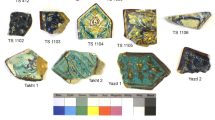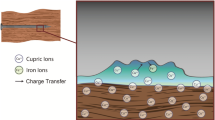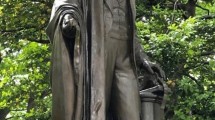Abstract
In this work, we applied scanning electron microscopy (SEM), microanalysis and Raman spectroscopy to study the fungi inhabiting a richly illuminated parchment document and the damage induced by their activity. To that aim, we collected samples of fungal mycelium from the deteriorated areas on a removable adhesive tape specifically intended for lifting fungi without damaging the support. SEM analysis of the adhesive tape samples showed the co-occurrence of several species of fungi. One strain closely resembling Acremonium species was observed only in the tape micrographs but no agar cultures were obtained. Its fungal structures showed the production of abundant oxalates with an outstanding leaching of the calcium-based materials of parchment (typically manufactured with gypsum and lime). Needle-like crystals of calcium oxalate produced by the fungus forming a uniform and quite regular grid around conidial slimy heads were documented. As a result, the areas affected by moulds were weakened, stained and characterised by a powdery patina rich in calcium. Confocal μ-Raman confirmed the presence of oxalates while EDS showed the presence of calcium in crystals. We conclude that the defacement of the parchment was due to both collagenolytic activity, and to the biotransformation of calcium-based minerals by fungi.










Similar content being viewed by others
References
Pinzari F, Colaizzi P, Lunghini D, Maggi O (2010) Cultured fungi: fungal assemblages that affect cultural heritage in archives and libraries. Proceedings of the 9th International Mycological Congress, IMC9 The Biology of Fungi. 1–6 August, Edinburgh, UK
Reed R (1972) Ancient Skins Parchments and Leathers. Department of Food and Leather Science, University of Leeds. Seminar, London, England
Florian M-L E (2007) Protein facts. Fibrous proteins in cultural and natural history artifacts. Archetype, London
Karbowska-Berent J, Strzelczyk AB (2000) The role of Streptomycetes in the biodeterioration of historic parchment. Nicholas Copernicus University, Torun, Poland
Polacheck I (1989) Damage to an ancient parchment document by Aspergillus Mycopathologia. Kluwer, Belgium, 106:89–93
Petushkova JP, Koestler RJ (1996) Biodeterioration studies on parchment and leather attacked by bacteria in the Commonwealth of Socialist States. International Conference on Conservation and Restoration of Archival and Library Materials, Erice, I: 195–211. 22–29 April
Rebrikova NL, Dmitrieva MB (1996) Experimental Investigation of Parchment Manuscripts with Traces of Microbiological Damage International Conference on Conservation and Restoration of Archival and Library Materials. Erice 1:275–283, 22–29 April
Kowalik R (1980) Microbiodeterioration of library materials Part 2. Microbiodecomposition of basic organic library materials. Chapter 4. Denmark. Restaurator 4:200–208
Samson RA, Varga J (2007) Aspergillus sytematics in the genomic era. Stud Mycol 59:206
Domsch KH, Gams W, Anderson TH (1980) Acremonium Link. Ex Fr 1821 pp 16 compendium of soil fungi. Academic, London
Fincher RM, Fisher JF, Lovell RD, Newman CL, Espinel AI, Shadomy HJ (1991) Infection due to the fungus Acremonium (Cephalosporium). Med (Baltimore) 70:398–409
Pitt JI, Hocking AD (1997) Fungi and food spoilage, 2nd edn. Blackie, London
Pinzari F, Montanari M, Michaelsen A, and Pinar G (2010) Analytical protocols for the assessment of biological damage in historical documents. Coalition Newsletters 19:6–12 (ISSN 1579–8410 5, www.rtphc.csic.es/boletin.htm)
Druzhinina IS, Schmoll M, Seiboth B, Kubicek CP (2006) Global carbon utilization profiles of wild-type, mutant, and transformant strains of Hypocrea jecorina. Appl Environ Microbiol 72:2126–2132
Lundgren B (1981) Fluorescein diacetate as a stain of metabolically active bacteria in soil 36. Blackwell, Oikos, pp 17–22
Goldstein JI, Newbury DE, Echlin P, Joy DC, Lyman CE, Lifshin E, Sawyer L, Michael JR (2003) Scanning electron microscopy and X-ray microanalysis. Kluwer, New York, 689 pp
Hall TA, Gupta BL (1984) The application of EDXS to the biological sciences. J Microsc 136:193–208
Zyska B (1997) Fungi isolated from library materials: a review of the literature. Int Biodet & Biodeg 40:43–51
Samson RA, Houbraken J, Thrane U, Frisvad JC, Andersen B (2010) Food and Indoor Fungi, CBS Laboratory Manual Series, CBS-KNAW Fungal Diversity Centre, ISBN 978-90-70315-82-3, 390 pp
Hughes SG (1968) Diploospora. Can J of Botany, (Notes) 46(9):1159–1160
Grove WB (1916) New or noteworthy fungi. J Botany, London 54:217–223
Edwards HGM, Farwell DW, Jenkins R, Seaward MRD (1992) Vibrational Raman spectroscopic studies of calcium oxalate monohydrate and dihydrate in lichen encrustations on renaissance frescoes. J Raman Spectrosc 23:185–189
Edwards HGM, Farwell DW (2008) The conservational heritage of wall paintings and buildings: an FT-Raman spectroscopic study of prehistoric, Roman, mediaeval and Renaissance lime substrates and mortars. J Raman Spectrosc 39:985–992
Gadd GM (2007) Geomycology: biogeochemical transformations of rocks, minerals, metals and radionuclides by fungi, bioweathering and bioremediation. Mycol Res 111:3–49
Michaelsen A, Pinzari F, Ripka K, Lubitz W, Piñar G (2006) Application of molecular techniques for identification of fungal communities colonising paper material. Int Biodet & Biodeg 58:133–141
McGill WB, Cole CV (1981) Comparative aspects of cycling of organic C, N, S, and P through soil organic matter. Geoderma 26:267–286
Higashi M (1993) An extension of niche theory for complex interactions. In Mutualism and Community Organization: Behavioural, Theoretical, and Food-Web Approaches. Kawanabe H et al (eds) Oxford University Press, pp 311–322
Strzelczyk A (2001) Adaptation to fungicides of fungi damaging paper. Int Biodet & Biodeg 48:255–262
Author information
Authors and Affiliations
Corresponding author
Additional information
Published in the special issue Analytical Techniques in Art, Archaeology and Conservation Science with guest editor Oliver Hahn.
Rights and permissions
About this article
Cite this article
Pinzari, F., Colaizzi, P., Maggi, O. et al. Fungal bioleaching of mineral components in a twentieth-century illuminated parchment. Anal Bioanal Chem 402, 1541–1550 (2012). https://doi.org/10.1007/s00216-011-5263-1
Received:
Revised:
Accepted:
Published:
Issue Date:
DOI: https://doi.org/10.1007/s00216-011-5263-1




